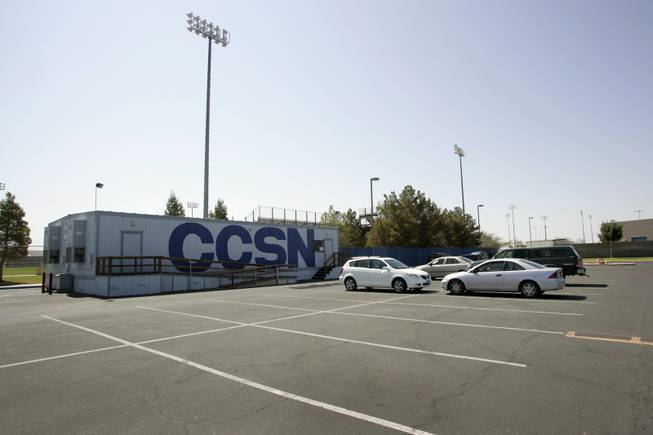
Moapa Valley High students take college classes in this center behind their school. CSN expects to keep it and one in Las Vegas open despite a deep funding cut. The letters CCSN stand for Community College of Southern Nevada, CSN’s former name.
Monday, March 30, 2009 | 2 a.m.
Sun Archives
- In limbo: Status of ‘save our satellite’ pleas to CSN (3-19-2009)
- Budget cuts would narrow CSN's reach (11-20-2008)
- Budget cuts are students' loss (7-12-2008)
- Rural campuses at risk (12-13-2007)
Sun Archives
Even under what some higher education officials have called a “doomsday scenario,” the College of Southern Nevada would likely keep open two learning centers it had planned to close if it endured large budget cuts.
Last summer, the college announced plans to shut down six satellite campuses — those in Boulder City, Lincoln County and the Moapa Valley, along with three in Las Vegas.
Last week, however, in a memo explaining how Nevada’s public college system would deal with a budget giving the system the amount of government funding, possibly including federal stimulus money, that it received in fiscal 2006, CSN singled out only four centers for closure.
Under that reduction, college officials think they could preserve the Moapa Valley site and one in Las Vegas by Sahara Avenue and Valley View Boulevard, said CSN spokeswoman K.C. Brekken.
Moapa Valley residents have been fighting to maintain their CSN campus since the college proposed shutting it down. Members of the community met in January with CSN President Michael Richards and Dan Klaich, the higher education system’s executive vice chancellor, to make their case for keeping their center, which offers college-level courses for high school students during the school day.
The Las Vegas site offers classes including English as a second language and training for health professionals providing emergency care. Thousands of students visit the center each year, its coordinator said in November.
•••
UNLV student body President Adam Cronis scurried around the school’s academic mall on Thursday afternoon, busy with final preparations for an anti-budget-cut rally to begin at 6 p.m.
Later that evening and the next day, media outlets would report that the turnout was “small.” But Cronis didn’t know yet what to expect. A January protest had drawn more than 3,000 participants, and student leaders at Southern Nevada’s three public colleges were eager to show they could bring out their peers again.
Organizers had been working on the Thursday event for weeks. Now, half an hour before the scheduled start time, Cronis, in a casual jacket and blue jeans, seemed slightly tense. He wondered where missing volunteers were — late? Not planning to show up? A strong, steady wind was blowing across the campus, sending papers — form letters, lists of legislators’ contact information — flying.
“Worried?” he said in response to a question on whether he was nervous. “I’m worried about the wind right now.”
About 5:30 p.m., a couple of students came to the rescue with a collection of gray and orange rocks — makeshift paperweights. Cronis met them with enthusiasm: “Gosh, thank you. You’re really coming through big for us.”
Cronis, soft-spoken but articulate, is running unopposed to keep his job next year, and at the rally, everyone seemed to want his attention. Constituents flagged him down to talk about their problems. At 5:45 p.m., a couple of television reporters in suits and ties waved him over for an interview. He greeted them with the same smile and handshake he gives students.
If UNLV were to suffer large cuts, Cronis told the cameras, “we would be a shell of an institution ... We might have thousands of students getting turned away.”
By 6:15 p.m., just a few hundred protesters had arrived. Cronis gazed at the sparse crowd from behind his wire-rimmed glasses. “They’re starting to come out,” he said tentatively to a friend who replied, “I wouldn’t worry.”
Cronis took the stage to talk about the importance of higher education, then spent the next hour listening to student speakers and chatting with friends about the turnout. He guessed that 1,500 people had come. But at any time, only a few hundred were gathered.
As the rally wound down, Cronis said he wasn’t disappointed. Still, his comments were reserved. He said he had expected a smaller crowd than in January.
As a friend told him, “it’s like a sequel, you know?”
•••
The College of Southern Nevada is, for the first time, holding tryouts to choose its commencement keynote speaker.
In the past, the school invited guests such as higher education administrators to give the big talk. This year, students interested in giving the address will compete for the honor, presenting their speeches in April to a panel of judges.
The change has nothing to do with budget cuts, according to the college. Past guest speakers were not paid, but generally received a small gift, such as a plaque, with a college logo on it.

Join the Discussion:
Check this out for a full explanation of our conversion to the LiveFyre commenting system and instructions on how to sign up for an account.
Full comments policy